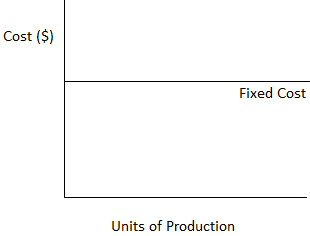Fixed costs are costs that remain constant in total within a relevant range of volume or activity. Here, the concept of the relevant range is critical; it refers to the range of activity that the company expects to operate in. Alternatively, a fixed cost is a cost that does not vary and, in this way, remains constant over a given period. It also stays in a specific range of activity despite fluctuations in production volume. Examples of fixed costs include: Fixed costs (or constant costs) are costs that are not affected by an increase or decrease in production. That is to say, fixed costs remain constant for a given period despite changes in production volume. For practical purposes, this definition of fixed cost can be changed slightly. A fixed cost will change over time due to situational factors that are not impacted by a firm’s activity (e.g., rent or taxes may change). As such, a cost is fixed only within a limited time period. Hence, the reference to a time period is essential for the concept of fixed costs. It implies that, in the long run, all costs tend to be variable. The diagram below illustrates the concept of fixed costs. Total fixed costs are shown by a straight line drawn parallel to the x-axis because fixed costs do not respond to changes in volume or activity.Fixed Costs: Definition
Examples of Fixed Costs
Fixed Costs: Explanation

Characteristics of Fixed Costs
Fixed Costs FAQs
Are costs that are not affected by an increase or decrease in production. That is to say, fixed costs remain constant for a given period despite changes in production volume.
Depreciation, rent, insurance, advertising, and plant superintendent’s salary are examples of a fixed costs.
A fixed cost remains constant over a given period. Per-unit fixed cost is inversely proportional to output (i.E., It decreases as output increases, while it increases as output decreases). Its allocation to departments or cost centers is generally made by managerial decisions that typically adopt various cost apportionment methods. Top management personnel (rather than departmental supervisors) are responsible for controlling fixed costs. Fixed costs are not fixed for the long term
Fixed costs are independent of the number of goods or services produced; variable and total costs depend on the number of goods or services produced.
To determine your total fixed costs, subtract the sum of your variable costs for each unit you produced from your total cost of production.
True Tamplin is a published author, public speaker, CEO of UpDigital, and founder of Finance Strategists.
True is a Certified Educator in Personal Finance (CEPF®), author of The Handy Financial Ratios Guide, a member of the Society for Advancing Business Editing and Writing, contributes to his financial education site, Finance Strategists, and has spoken to various financial communities such as the CFA Institute, as well as university students like his Alma mater, Biola University, where he received a bachelor of science in business and data analytics.
To learn more about True, visit his personal website or view his author profiles on Amazon, Nasdaq and Forbes.











